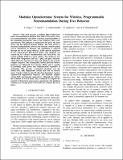| dc.contributor.author | Orguc, Sirma | |
| dc.contributor.author | Sands, Joanna | |
| dc.contributor.author | Sahasrabudhe, Atharva | |
| dc.contributor.author | Anikeeva, Polina Olegovna | |
| dc.contributor.author | Chandrakasan, Anantha P | |
| dc.date.accessioned | 2021-06-22T16:19:03Z | |
| dc.date.available | 2021-06-22T16:19:03Z | |
| dc.date.issued | 2020-08 | |
| dc.date.submitted | 2020-07 | |
| dc.identifier.isbn | 9781728119908 | |
| dc.identifier.issn | 2694-0604 | |
| dc.identifier.uri | https://hdl.handle.net/1721.1/131026 | |
| dc.description.abstract | This work presents a modular, light-weight head-borne neuromodulation platform that achieves low-power wireless neuromodulation and allows real-time programmability of the stimulation parameters such as the frequency, duty cycle, and intensity. This platform is comprised of two parts: the main device and the optional intensity module. The main device is functional independently, however, the intensity control module can be introduced on demand. The stimulation is achieved through the use of energy-efficient μLEDs directly integrated in the custom-drawn fiber-based probes. Our platform can control up to 4 devices simultaneously and each device can control multiple LEDs in a given subject. Our hardware uses off-the-shelf components and has a plug and play structure, which allows for fast turn-over time and eliminates the need for complex surgeries. The rechargeable, battery-powered wireless platform uses Bluetooth Low Energy (BLE) and is capable of providing stable power and communication regardless of orientation. This presents a potential advantage over the battery-free, fully implantable systems that rely on wireless power transfer, which is typically direction-dependent, requires sophisticated implantation surgeries, and demands complex custom-built experimental apparatuses. Although the battery life is limited to several hours, this is sufficient to complete the majority of behavioral neuroscience experiments. Our platform consumes an average power of 0.5 mW, has a battery life of 12 hours. | en_US |
| dc.description.sponsorship | National Institute of Neurological Disorders and Stroke (Grant 5R01NS086804) | en_US |
| dc.publisher | Institute of Electrical and Electronics Engineers (IEEE) | en_US |
| dc.relation.isversionof | http://dx.doi.org/10.1109/embc44109.2020.9175600 | en_US |
| dc.rights | Creative Commons Attribution-Noncommercial-Share Alike | en_US |
| dc.rights.uri | http://creativecommons.org/licenses/by-nc-sa/4.0/ | en_US |
| dc.source | Sirma Orguc | en_US |
| dc.title | Modular Optoelectronic System for Wireless, Programmable Neuromodulation During Free Behavior | en_US |
| dc.type | Article | en_US |
| dc.identifier.citation | Orguc, S. et al. "Modular Optoelectronic System for Wireless, Programmable Neuromodulation During Free Behavior." 42nd Annual International Conference of the IEEE Engineering in Medicine & Biology Society (EMBC), July 2020, Montreal, Canada, Institute of Electrical and Electronics Engineers, August 2020. © 2020 IEEE | en_US |
| dc.contributor.department | Massachusetts Institute of Technology. Department of Electrical Engineering and Computer Science | en_US |
| dc.relation.journal | 42nd Annual International Conference of the IEEE Engineering in Medicine & Biology Society (EMBC) | en_US |
| dc.eprint.version | Author's final manuscript | en_US |
| dc.type.uri | http://purl.org/eprint/type/ConferencePaper | en_US |
| eprint.status | http://purl.org/eprint/status/NonPeerReviewed | en_US |
| dspace.date.submission | 2021-06-21T14:04:29Z | |
| mit.license | OPEN_ACCESS_POLICY | |
| mit.metadata.status | Complete | |
